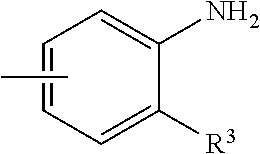Crosslinkable fluorine rubber composition, fluorine rubber molded article, and method for producing the same
- Summary
- Abstract
- Description
- Claims
- Application Information
AI Technical Summary
Benefits of technology
Problems solved by technology
Method used
Image
Examples
example 1
Step (I)
[0204]A dispersion (polymer content: 24% by mass) of the fluororubber (A) and a dispersion (polymer content: 32% by mass) of the fluororesin (B) were mixed such that the solids content ratio of the fluororubber (A) to the fluororesin (B) was 70:30. The resulting mixture was named dispersion D.
[0205]Next, 400 g of the dispersion D was added to 500 g of pure water. The mixture was further mixed with 2 g of aluminum sulfate while being stirred with a mixer. The mixture was stirred for about three minutes and the solids content was removed.
[0206]The solids content was dried at 80° C. in an oven for 20 hours. The resulting product is a co-coagulum.
[0207]The obtained co-coagulum was placed around two 8-inch rolls in an open roll, and 14 parts by mass of the filler and 0.3 parts by mass of the ammonia-producing compound were added to 100 parts by mass of the co-coagulum. The obtained mixture was kneaded for 20 minutes. The mixture was then cooled for 24 hours, and kneaded again at ...
PUM
| Property | Measurement | Unit |
|---|---|---|
| Temperature | aaaaa | aaaaa |
| Temperature | aaaaa | aaaaa |
| Temperature | aaaaa | aaaaa |
Abstract
Description
Claims
Application Information
 Login to View More
Login to View More - R&D
- Intellectual Property
- Life Sciences
- Materials
- Tech Scout
- Unparalleled Data Quality
- Higher Quality Content
- 60% Fewer Hallucinations
Browse by: Latest US Patents, China's latest patents, Technical Efficacy Thesaurus, Application Domain, Technology Topic, Popular Technical Reports.
© 2025 PatSnap. All rights reserved.Legal|Privacy policy|Modern Slavery Act Transparency Statement|Sitemap|About US| Contact US: help@patsnap.com



